| Columns Retired Columns & Blogs |
... a design engineer from Bowers & Wilkins who can explain why their speakers tend to exhibit "somewhat idiosyncratic measured behavior."
I used DRA Labs' MLSSA system and a calibrated DPA 4006 microphone to measure 7the Bowers & Wilkins 702 S2's frequency response in the farfield, and an Earthworks QTC-40 for the nearfield responses. My estimate of the B&W's sensitivity was a high 90.2dB(B)/2.83V/m, confirming the specified 90dB. The 702 S2's nominal impedance is specified as 8 ohms, with a minimum value of 3.1 ohms. My measurement of the impedance magnitude (fig.1, solid trace) reveals that while the impedance does lie at and above 8 ohms in the low treble and in two regions in the bass, it actually drops below 6 ohms through much the audioband, with a minimum value of 3 ohms in the upper bass. There is also a current-hungry combination of 4 ohms and a –48° electrical phase angle at 88Hz. Although technically this is an 8 ohm design, I think it should be used with amplifiers that are comfortable with 4 ohm loads.
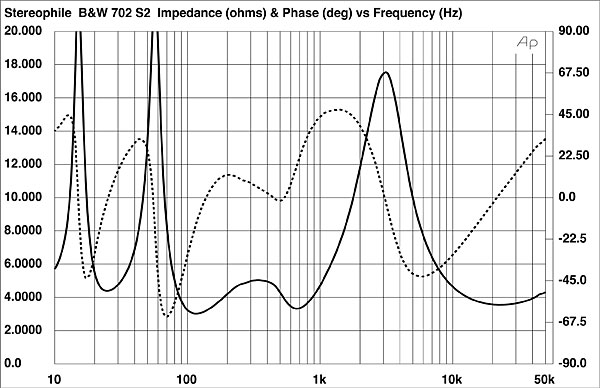
No discontinuities are visible in the impedance traces, but when I investigated the vibrational behavior of the enclosure with a simple plastic-tape accelerometer, I did find some resonant modes on the top and side panels. The highest-level mode, at 390Hz, was strongest on the side panels level with the midrange drive-unit (fig.2), accompanied by a second mode at 344Hz. As Kal Rubinson didn't comment on any midrange congestion that might have resulted from this behavior, I must assume that it looks worse than it sounds. (The audibility of panel resonances depends not only on their frequency and Q, or Quality factor, but also on the panel areas affected.)
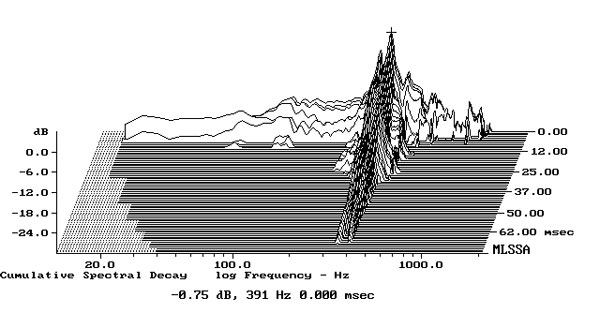
The saddle between 20 and 30Hz in the impedance-magnitude trace implies that the large, flared port on the rear panel is tuned to this frequency region—and, looking at the summed output of the three woofers measured in the nearfield (fig.3, blue trace; the three woofers have identical responses), this does have the expected minimum-motion notch at 26Hz. (At this frequency, the woofer cones are held stationary by the back pressure from the port resonance.) The port's output, again measured in the nearfield (red trace), peaks between 15 and 70Hz, and its upper-frequency rolloff is clean. The crossover of the woofers to the midrange unit (green trace) appears to be set just above 400Hz, with high-order rolloffs.
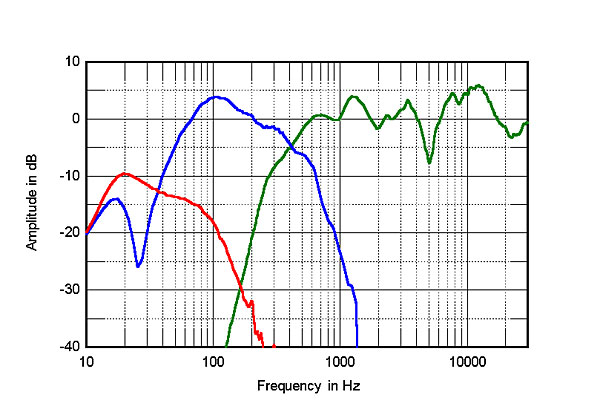
The farfield sections of the traces in fig.3 were taken on the tweeter axis, as was the blue trace in fig.4, which shows the 702 S2's farfield response averaged across a 30° horizontal window. I was surprised by the unevenness of the B&W's response on the tweeter axis, and so repeated the averaged measurements, this time centered on the midrange axis, which is 36" above the floor. (The tweeter axis is 42" high.) The result is shown by the red trace in fig.4. While still not as even as I would have expected from B&W, the mean level of the 702 S2's treble output is smoother. The sum of the nearfield outputs of the midrange, woofers, and port is shown as the black trace below 300Hz in fig.4; the apparent peak in the upper bass is entirely an artifact of the nearfield measurement technique, which assumes that the radiators are mounted in a true infinite baffle; ie, one that extends to infinity in both planes. However, the port's output doesn't fully extend the 702 S2's low-frequency response with this quasi-anechoic measurement; I suspect that this is because B&W anticipates that the port's output will benefit from some boundary reinforcement, as the port is close to the floor. KR did note that the B&W's low frequencies sounded "full and firm," though he also commented on the lack of "room boom."
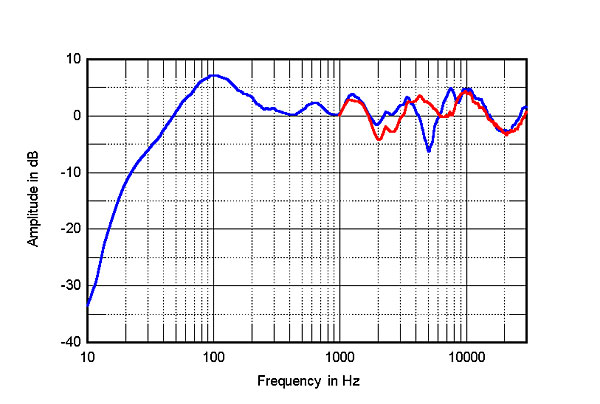
Fig.5 shows the 702 S2's lateral radiation pattern normalized to the tweeter-axis response, which therefore appears as a straight line. This graph reveals that the sharply defined suckout at 5kHz in the farfield response on this axis, seen in figs. 3 and 4, does fill in to the speaker's sides. The output of that relatively large-diameter midrange cone does become somewhat directional between 2 and 4kHz, but the speaker's horizontal dispersion is otherwise even. In the vertical plane (fig.6), the suckout in the tweeter-axis output at 5kHz deepens above that axis and fills in below it. KR didn't find the 702 S2s very sensitive to where he placed them in his room, but these graphs suggest that experimenting with speaker toe-in and the listener's ear height will be necessary to get the most neutral treble balance from this speaker.
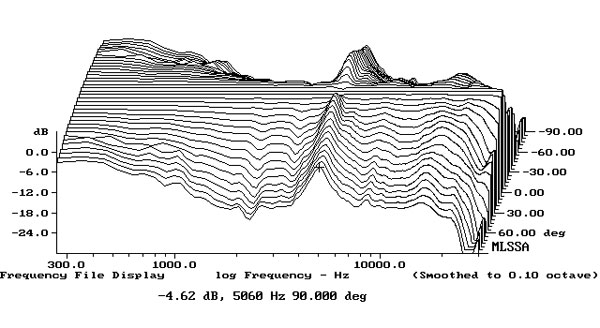
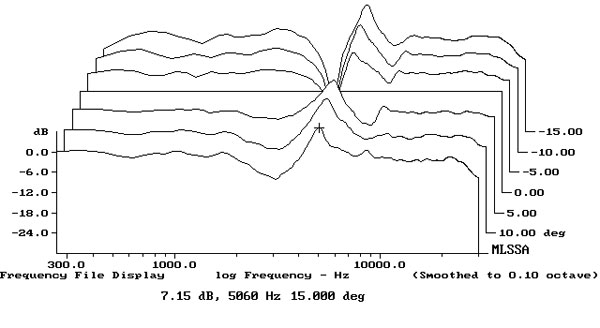
Turning to the time domain, the slight discontinuity just before the 4ms mark in the tweeter-axis step response (fig.7) confirms that the optimal blend between the midrange unit and the tweeter occurs just below that axis. This graph also indicates that all five drive-units are connected in positive acoustic polarity. The cumulative spectral-decay plot on the tweeter axis (fig.8) is disturbed by the lack of drive-unit integration on this axis, but is otherwise clean in the treble.
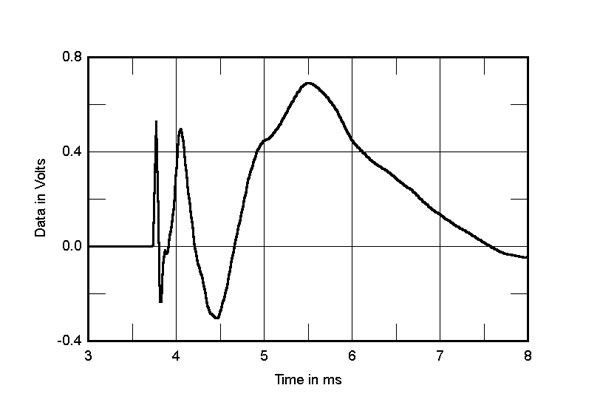
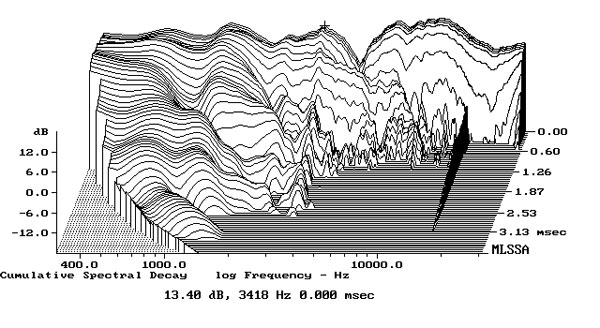
Bowers & Wilkins loudspeakers tend to have somewhat idiosyncratic measured behavior, and the 702 S2 is no exception. But with careful setup and choice of ancillary components, it can produce very satisfying sound, as KR found.—John Atkinson

... a design engineer from Bowers & Wilkins who can explain why their speakers tend to exhibit "somewhat idiosyncratic measured behavior."

Even more interesting would be to ask why they don't tell people how to properly set up the loudspeaker? The multi-way B&W speakers are designed with a specific listening distance and listening axes in mind. Most measurements that are seen in the mags are not performed on the correct axes which is often reflected in the measurements, e.g., the tweeter is too high for the measurement or listening axis. I received this info from a knowledgeable B&W employee. None of this critical set-up info can be found in the owner's manual! Once the speakers are set up as intended, they truly can sound magical and virtually disappear. If you have the patience with the "fussy" set-up process, it can really yield great rewards.

... a design engineer from Bowers & Wilkins who can explain why their speakers tend to exhibit "somewhat idiosyncratic measured behavior."
I'd say their signature large midrange driver and small tweeter on top arrangement probably got a lot to do with it.

I don't disagree with this, but I think it deserves a bit more explanation for the uninitiated.
This particular design choice (large midrange cone, together with small "pod" tweeter) is thorny because it involves a sudden and very extreme directivity transition, from narrow beamwidth at the top end of the midrange to extremely wide beamwidth at the bottom end of the tweeter. It looks like even with these difficulties, the response of the speaker is "fairly" flat, in that it seems to fall within +/-3dB from the lower midrange to the high treble, with the exceptions being a saddle near 20kHz and a sharp dip although this is only seen in JA's full-bandwidth measurement on the tweeter and midrange axes because this is the only graph that properly captures the summation between all three drivers (the separate graphs for port, woofer, midrange, and tweeter does not give any indication of this, only the 'acoustic' crossover frequencies). The lack of consistent directivity will be the thing that has the biggest influence on how well the speaker will mate with a particular room and placement, and the overall response is not as "flat" as has been seen in other speakers, probably as a result of trying to compensate for highly variable directivity over the speaker's range.
As a designer, if I wanted to use a large midrange driver like the FST used by B&W, I would see the need to incorporate a waveguide to modify the directivity of my tweeter to match closely through the crossover region.

In the 800 series B&Ws, the contours of the "pod" tweeter blend curvaceously into the contours of the spherical-front midrange pod, helping to smooth the acoustical transition at crossover. Here, both mid driver and tweeter "see" a hard sharp edge at 90 degrees off axis. Any diffraction modeling software will show the resulting disturbances (sharp peaks and dips) that this causes in the on-axis response.
Add to this that the mid/tweet crossover is set too high: few if any 6" drivers are capable of linear output up to 4kHz, and the acoustic centers of the drivers are way more than one wavelength apart, so you'll get a lot of comb filtering effects above and below the optimum vertical listening axis. AND the tweeter's first order highpass filter is too shallow: it will still have significant output an octave below, introducing further phase anomalies and contributing to the difficulty of finding that optimum axis.
This is all basic, established knowledge, so I truly don't understand why B&W's engineers fail to take it into account! The brand has pioneered some wonderful innovations in driver and cabinet design, so why can't they get their crossovers right? I've heard maybe half a dozen B&W models over the years, and all (to my ears, anyway) required fussy positioning, and still sounded too bright and ultimately fatiguing in the treble.

To see other comparisons at this price point, Revel F208's for example. B&W's always strike me as a bit of a crap shoot compared to other brands. More sensitive to the room, to placement, to the electronics in use.

Hi Kal,
Since you also reviewed the 683 S2 a couple of years ago I am eager to hear your comparison and contrast of 702 S2 with the 683 S2. Based on the review details and measurements they seem very similar except that 702 S2 has newer drivers with better materials and a better looking cabinet and finish. I was thinking about upgrading but now not sure. Your thoughts?
Another candidate for my upgrade is Revel F208 as mentioned by brenro above. F208 appears to be better in measurements and in listening tests at almost the same price point.
Thanks!

There are, undoubtedly, major technical advances in the 702 S2 that go well beyond anything in the 600 series. However, I cannot offer any subjective comparative information because it has been quite a while since I heard the 683 S2 for that review and it was in my CT house/system while the 702 S2 was used in my NYC apartment.

I can't help but think that this idiosyncratic measured behaviour of the less expensive models is a deliberate design choice (I'm not going to speculate as to the reasons here). It is not difficult nor expensive to add a couple of crossover components and iron out the measured upper-midrange mess. Not ok.

It would be great it we could get a plot of the lateral response both with and without normalization.

Why no comparison to the similar sized and recently reviewed Monitor Audio Silver 300s? After all, they perform better on paper despite the price gap. Why not tell readers why they should consider forking over $2500 more for speakers that don't measure as well. It's no surprise that speakers of the same lineage sound similar, that's not very helpful. It's better to help us understand why one might choose B&W over the competition.

Hi Kal,
How would you compare and contrast this with Monitor Audio's Silver 300 which you reviewed recently (Feb'18)? Measurements seem to be better for Silver 300
Thanks

As noted above the 702 S2 was auditioned in NYC and the MA S8 and S300 were auditioned in CT. The reason is kinda lame but I am no longer willing to do heavy stuff in CT where I have to do the schlepping and lifting myself. In NYC, I have help. (The Parasound A52+ was the ton of straw and almost broke the camel's back.)
So, all I can say about all these, as a group, is that I am happy to keep the Silver8 speakers after having auditioned the 683 S2 and the Silver300 in the same room. I was not tempted to consider the more costly 702 S2 for that system.

I have a problem with multiple drivers doing the same job, as no driver is a perfect match to another, yet alone 3 of them trying to move in perfect unison, there has to be more distortion.
Maybe that's why the reviewer found the bass of the 804 D3 was more defined and tonal at the very bottom end because it only has 2 drivers doing the same job. The highest distorting component in audio is the bass speaker, here we are trying to make 3!!! of them work as a perfect single unit, it aint guna happen.
Maybe one 8" low bass and one 6" upper bass would be better again, and make the thing a 4 way.
Cheers George

If all three drivers are being driven in unison by a common signal, and if all three drivers are equivalent, they should move perfectly in unison. There are only a few things that could cause drivers in a common chamber with a common drive signal to move in a non-unison fashion, one of which being an extremely strong standing wave inside the enclosure that causes the pressure behind the drivers to be uneven at certain frequencies, another possibility being the existence of filtering that causes one driver to receive an out-of-phase signal, and a third being a non-functioning driver with no electrical connection to the amplifier, so it would only be moving in response to enclosure pressure. Any one of these issues would show up in a frequency response measurement as an unexpected artifact in the bass response (ripple or low level) or a mismatch between the two speakers. Even under these conditions, the response of the drivers to a transient should be proportional, and not out-of-sync with one another.
There are other things, such as electrical and mechanical damping of the drivers, the combined damping of the vented system, and a different tuning frequency, that would be much more probable in causing differences in bass character between one speaker and another.

Maybe one 8" low bass and one 6" upper bass would be better again, and make the thing a 4 way.
The introduction of this additional complexity would raise cost and reduce bass output capability.

I've never been able to measure the T&S parameters of two let alone three drivers three to be identical, even when buying "matched pairs" from a manufacture for repairs.
As I said the bass driver is the worst component for distortion, and here we are making it even worse, and nowhere does it even say these are match, which would help but not totally eliminate as the matching wouldn't be perfect.
Cheers George

first off, doubling the number of bass drivers should reduce the distortion at any given volume level. 2 8" woofers require half as much power to reach a given volume level as a single 8" woofer of the same model in the same sized box/driver (some speakers give each woofer its own subenclosure, some don't). Less power = less cone excursion and less voice coil heat = less distortion. Three woofers will reduce the distortion further.
second, you seem to (incorrectly) believe that drivers actually exactly match their Thiele/Small paramaters and that isn't the case in the real world except inadvertantly. All manufacturing is done to a specified tolerance, and more expensive speaker drivers tend to be made to tighter tolerances than cheaper ones. Really expensive finished speakers often have their crossovers tailored to the individual drivers - gives great sample to sample matching but makes driver replacement waaaaay more complicated and expensive... but then, if you're dropping over $50 grand on a pair of speakers you can probably afford it.
Oh, and unless otherwise noted, it's quite safe to assume the woofers are all the same because that's how pretty much everyone rolls.

Sorry to me use one "correct" driver within it's limits to do the job, and if it costs more so be it.
It comes from measuring the Thiel and Small speaker parameters on many drivers.
http://1.bp.blogspot.com/-7euZZb2iGdI/UwI5lIr62FI/AAAAAAAACQc/bIm0r1zxDco/s1600/Thiel+And+Small+Parameters+-+Alberto+A+Lopez+-.jpg
No two are perfectly alike with all measurements, and you need that here so there is absolutely no smearing effect of the drivers not moving in perfect unison stopping and starting as one. Same goes for multiple tweeters and midranges.
Cheers George

"No two are perfectly alike with all measurements, and you need that here so there is absolutely no smearing effect of the drivers not moving in perfect unison stopping and starting as one."
So you only listen in mono with a single speaker then? That's the logical end point of what you believe (well, really it's a single driver like a Lowther in mono). Since no two speaker drivers are identical, you're going to get that "smearing effect" regardless of how you set up your speakers whenever you have primarily mono low bass (pretty much all music outside of classical, some jazz, and some EDM).
The drop in distortion alone from adding a second woofer dwarfs the effect of slightly differing T/S parameters (and those parameters aren't even static, they change as the driver ages - especially the suspension components aging).
It's a forest, not just a bunch of trees.

Sorry but you can't see the forest through the trees. Three drivers cannot be in perfect unison as one can that's dedicated to the job.
Cheers George

Any classical music lover noticed that the generation of dynamic classical music recording such as Mercury Living presence and the great hours of Decca sound engineers left the stage sometime in the 1990s replaced by a slew of anaemic recordings claiming to offer a wide sound stage, and the infinite details of the hall acoustics etc... Sadly, the dynamics of these recording were nonexistent: at best, some noise was happening down there, somewhere far and orchestral tutti barely registered, often a soup combining reflected and direct sound. From being on the podium with the conductor, listeners were relegated to the rafters. Digging information, it was explained that these recordings were mastered on B&W speakers, then the self declared new reference for "classical music".
I contend that using such low efficiency speakers and the marketing of such logs that surely could never bother any neighbour even in wafer thin walled condos has had a nefarious influence on the recording style adopted during these years by recording labels. This has contributed in turn to the revival of high dynamics recordings, the music alive that were found on the great labels mentioned above, and thus the great vinyl revival.
As for classical recordings of the 90s era, high rez downloads now available can help compensate for their lack of dynamics... and B&W churning another 90dB/w/m "softspeaker".

I do not understand why B&W still uses no-baffle-for-tweeter design.
Many designers go in the opposite direction. They use more than a baffle for tweeter: wave guide, short horn, etc. to match directivity of the mid range driver at the crossover.

"Idiosyncratic" is a euphemism for inaccurate and colored but no one dares give any Bowers and Wilkins product a bad review for obvious reasons. I agree with J.P. Jackson above that the inaccuracy of the 702 is a deliberate design choice. I have owned Bowers and Wilkins speakers in the past and found that although they are decent, they have an obvious coloration, which usually consists of a recessed upper midrange and somewhat exaggerated highs. My assessment of the B and W "flavoring" is entirely consistent with the measured frequency response of 702 shown above. I had to install a 1.5 ohm resister in place of the jumper on the biwire cable jack to bring the highs down to a tolerable level. I think the B and W started out as a very good and accurate speaker but started to deviate more and more from accuracy in the quest to increase their market share. This process accelerated when they started selling their 600 and 700 series speakers at Best Buy. They have become more and more about marketing and gimmickry. John Bowers, the company's founder, is quoted as saying the ideal is a speaker that "neither adds nor subtracts" from the original performance. That is how the company started out but it is has been through several ownership changes since then. I wonder now if Mr. Bowers is rolling in his grave. If you like the coloration of the B and Ws, go for it. However, if you are looking for a more accurate speaker in the price range of the 702, you would be better off considering speakers from Revel, Focal, and Monitor Audio, to name a few. Also, the NHT C-4 is far more accurate for less than half the price.

If anyone cares to examine the response plots for tweeter and fst mid axes, clearly, the intended listening axis is roughly mid way between the two.
All B&W 700 / 800 series exhibit the same mid-treble irregularities to some extent, due to the crossover / driver integration design.
The response would be more even and uniform over a wider arc if the tweeter was inverted and "time aligned", and with higher order filters, but the B&W engineers decided on low order filters and made the decision to move the tweeter forward by a half wavelength rather than connect in reverse polarity. These design choices and reasons provided were articulated in the original Diamond 800 white paper if people care to read it.

I do not and will not understand why they took a speaker; a speaker that was literally artistic in design; and produced yet another rectangular "monkey coffin" as they used to be called.
Ouch that hurts; wtf B&W, wtf.

A very detailed article . I just got B & W 706 S2 speakers . I keep them on a book shelf with a the rear 0.25 m from the rear wall. It’s in a lobby with left , right snd front wall around 5 m away.i find the speakers bright this is after run in of about 20 hrs.
My q’s are -
1. Will a bass absorber on the rear wall help .
2. The speaker cable length needed is 2.5 m. What guage will be sufficient ?
3. Is bi wiring helpful as you have used the combination or single wire do
Note B&W customer care have suggested 12 guage bi wiring . I have option in between Mogami 2972 15 awg bi wire and Mogami 3104 12 awg bi wire .

What set up and ancillary components would you suggest for b & w 706 s2 speaker as I find them bright.